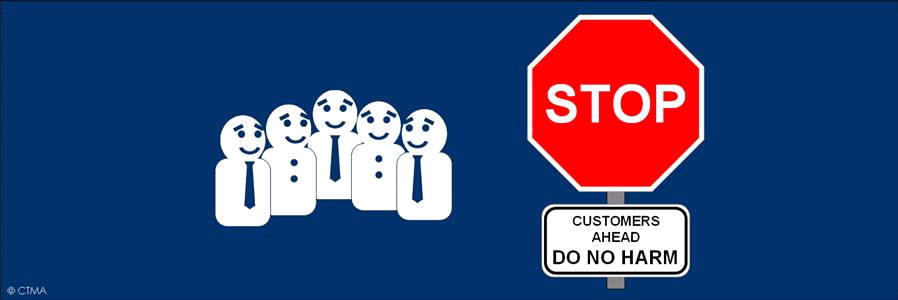Still known as the “Hippocratic Oath” (after one of its possible authors), in its various forms it still provides doctors today with an ethical framework in which to practice their skills, and provides their patients with a source of reassurance.
It’s now fashionable for businesses and government agencies to publish a “customer promise” – also intended to reassure their customers of their sincerity, care and professionalism.
But how many customer promises are backed up with the equivalent best practice frameworks, comprehensive training, and robust measurement disciplines that maintain the high standards of the medical profession? Or, how many of them merely reflect the aspirations of senior management or the marketing department?
Centuries of best practice, science and the development of ethical frameworks are behind the professionalism we have come to expect from medical practitioners. But as customers, how many of us feel the same sense of confidence in the products we buy and the services we receive from other providers such as airlines, car dealerships, real estate agents, banks, power companies, telcos, and insurance companies?
Should we not feel just as confident that they too will “do us no harm, avoid overtreatment, be unashamed to admit when they can’t help and refer us to someone who can”?
Alas, the customer experience research we’ve been conducting for more than ten years in multiple industries shows that it’s common for between thirty and fifty percent of an organisation’s customers to experience problems doing business with them. Imagine the horror if that level of service failure existed in the medical profession.
And would things be as bad if organisations really understood the damage that poor service inflicts on their businesses? Again from our research, we know that when problems occur, there is typically a drop in loyalty of about 25%. That’s a loss of approximately one in four customers who experience a problem.
I don’t for a single minute wish to trivialise the importance of the Hippocratic Oath in medicine, but if these same underlying convictions were applied in all customer/supplier relationships, then businesses, government agencies and customers would much more successful.
The starting point for any “customer promise” must be a genuine commitment to do no harm to customers, do no harm to staff, do no harm to suppliers, do no harm to the environment, and do no harm to the community. As customers – we would wish it, and as suppliers – we should honour it.
Testing your commitment
So if you’ve already published (or are about to publish) a customer promise, consider the following tests of your commitment:
- Assess your
organisation’s current performance
 by quantifying the problems that
customers experience and the impact they have on your business. If
harm is currently being done to customers, then you must address those
problems first - before making more promises that will in turn harm
your organisation too.
by quantifying the problems that
customers experience and the impact they have on your business. If
harm is currently being done to customers, then you must address those
problems first - before making more promises that will in turn harm
your organisation too. - Establish a continuous improvement resource and
operational framework
 for
ongoing measurement to systematically identify and
prioritise sources of customer dissatisfaction so you can take remedial actions
to address them. You will need a robust internal mechanism
to
ensure you are keeping your promises.
for
ongoing measurement to systematically identify and
prioritise sources of customer dissatisfaction so you can take remedial actions
to address them. You will need a robust internal mechanism
to
ensure you are keeping your promises. - Validate your readiness to make your customer
promise
 by checking that everyone in your organisation
understands the commitments you are making, and that the whole
organisation has the ability to deliver your customer promise.
Check that you have all the
necessary resources, skills, processes, systems, policies and
authorities in place, and that you are really ready
to go.
by checking that everyone in your organisation
understands the commitments you are making, and that the whole
organisation has the ability to deliver your customer promise.
Check that you have all the
necessary resources, skills, processes, systems, policies and
authorities in place, and that you are really ready
to go.
Complimentary working paper
 To
find out more about how much bad customer experiences may
already be costing your organisation, get your complimentary copy of our
working paper
“Counting the Cost of Bad Customer Experiences”.
To
find out more about how much bad customer experiences may
already be costing your organisation, get your complimentary copy of our
working paper
“Counting the Cost of Bad Customer Experiences”.
© CTMA New Zealand Ltd.
About the author: Paul Linnell
 Paul
Linnell is a customer experience and service quality improvement champion, working internationally
with senior managers and their teams to help them achieve business
success, reduce risk and build customer loyalty and advocacy by
improving service to customers. Paul specialises in the design
and deployment of customer experience measurement, service quality
improvement, complaints handling and preventive analysis programmes.
For most of his career he has worked in Europe and North America and
for the past 10 years Paul has been based in New Zealand, continuing
to serve clients globally.
Paul
Linnell is a customer experience and service quality improvement champion, working internationally
with senior managers and their teams to help them achieve business
success, reduce risk and build customer loyalty and advocacy by
improving service to customers. Paul specialises in the design
and deployment of customer experience measurement, service quality
improvement, complaints handling and preventive analysis programmes.
For most of his career he has worked in Europe and North America and
for the past 10 years Paul has been based in New Zealand, continuing
to serve clients globally.

